Having trouble deciding what type of nut to include in your next meal plan? The almonds vs. pistachios debate may be driving you nuts — pun intended — but we’re here to help. To clarify, both almonds and pistachios are technically seeds. However, they’re commonly identified as nuts. Almonds, known for their versatility in sweet, savory, and snacking dishes, are a wonderful addition to many kinds of food. Pistachios, with a crackable casing and lime green interior, are also quite easy to incorporate.
You can use these nuts as toppings and in desserts. Strain them for nut milk, crush them for kinds of butter, roast them with spices and sugars…the list goes on. Want to learn all about the differences between almonds vs. pistachios? Keep on reading!
First off, what makes these nuts so unique yet equally versatile? In this post, you’ll learn about the history and origin of almonds vs. pistachios. We’ll discuss their unique qualities, suggest some recipes and get down to the details. You’ll come away with some great ideas on how to incorporate these nuts into your next delicious meal. And from this point forward, you’ll always know the difference between almonds vs. pistachios! Happy reading!
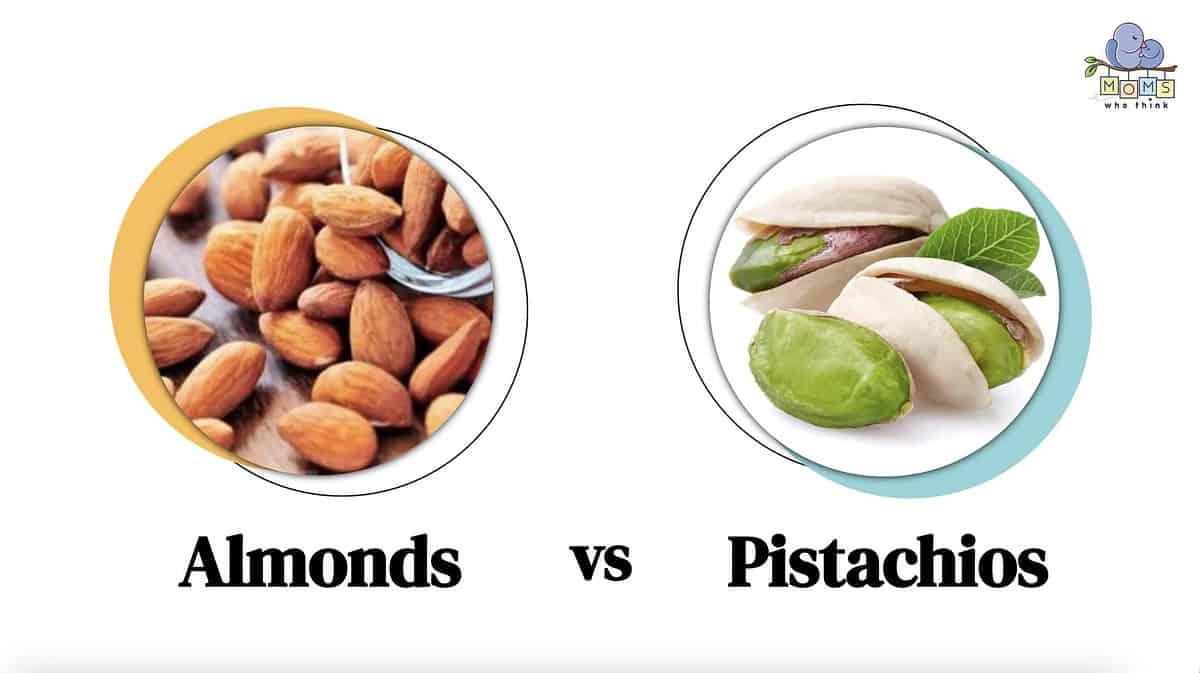
Almonds vs. Pistachios: What Is The Difference?
Almonds are a seed, encased in a fruit covering. The seed, or nut, is shaped like a long teardrop. The outer skin is typically brown with a light brown interior. Pistachios, on the other hand, have a hard outer shell. Crack this open to reveal the bright green seed kernel, or nut, which has a light brown casing that is also edible. These two seeds are similar in their versatility. You can use both almonds and pistachios in numerous meals, desserts, pastes, butter, and as simple, healthy snacks. However, they have quite different appearances, tastes, and origins and are from different plant families.
What Are Almonds?
Almonds, whose proper name is Prunus dulcis, are actually a member of the rose family (Rosaceae). They grow predominantly in the Mediterranean and in California. These nuts grow best in warm climates. Almonds are packed with protein, fat, and nutritious vitamins and minerals. There are two major types of almonds that are used in cooking, baking, and general food processing.
You can use the sweet almond for snacking and baking. Grind it down into flour, strain it into nut milk, or press it into an oil. Bitter almonds are more frequently used for extracts or flavoring liqueurs. The bitter almond has a much stronger taste (via Brittanica).
History and Origin of Almonds
Almonds grow on flowering trees in warm climates with healthy ground soil. Once pollinated, the almond tree fruit begins to grow. The almond seed rests in the hull of the fruit. Almonds have been consumed for centuries. The nut Is mentioned as far back as 400 B.C. Greek Mythology mentions almonds as a nutritional nut, and the Bible talks about the blossoming almond trees.
Throughout 900 A.D., almond trees were predominant in areas like Greece, Spain, and Israel, with the Silk Road trade routes spreading the seed far and wide. The almond blossom series by Van Gogh was painted during the 19th century, and the plants continued to be cultivated specifically in Spain throughout the 20th and into the 21st century. Modern-day, almonds are produced widely in the Fresno, San Joaquin, and Sacramento valleys. California has the largest production yield for almonds, producing around 80% of the world's supply (via Almonds.com).
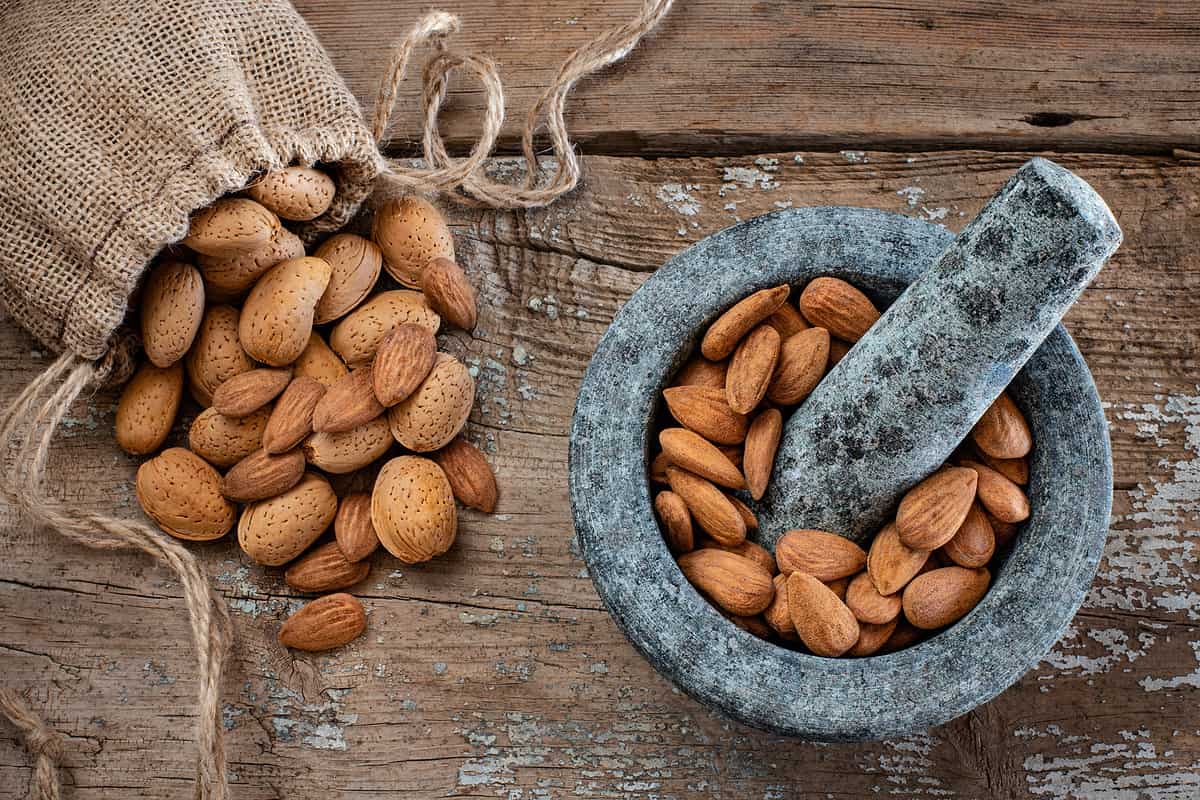
You can use almonds in baking, cooking, and for general snacking!
©iStock.com/Gulcin Ragiboglu
Recipes Using Almonds
Grind up almonds into flour. Almond flour is gluten-free and great for baking. You can strain almonds into dairy-free nut milk or crush them into almond butter. Chop up almonds and add them to a salad, or combine them with sugar and roast them for a sweet addition to any dish. There are almond extracts, almond liqueurs, and almond oils. You can find almonds even in your skincare! There are truly so many ways to use the almond.
Check out this great recipe involving almonds:
Easy Pastry Recipe with Pears and Almonds
What Are Pistachios?
Pistachios, or Pistacia vera, come from the cashew family. They, like almonds, grow best in warm climates. Appearance-wise, pistachios have a hard outer shell that can be cracked open to reveal the bright green seed. The seed is meaty and flavorful and filled with protein, fiber, fats, and even vitamin B. You can use pistachios in desserts and for all kinds of sweet and savory baking. You can also crush them into nut butter or roast them with spices for simple snacking.
History and Origin Of Pistachios
Pistachios have a history tracing them back to Iran. They are also cultivated all over the Mediterranean, in Afghanistan, as well as in the State of California. They grow on trees that bear fruits. These fruits eventually split to reveal the seed, which is protected by the hard outer shell.
Historically, pistachios have long-standing roots in Middle Eastern cooking. They are considered a delicacy. Early traces of their existence date back to the Old Testament (Genesis 43:11). They were a plant of high status in Persia and were frequently consumed by royalty. Pistachios spread through conquests, trade routes, and wars throughout Greece, Spain, and Italy.
After World War II, pistachios became more readily available. They transitioned from a baking delicacy to normalized snack food. They gained popularity in the states due to Middle Eastern immigrants and began to be sold in vending machines, bars, and train stations. Growing pistachios in the states called for finding a similar climate to their Middle Eastern origins. California was identified for its dry heat and fertile soil options. Thus, the modern-day American pistachio industry began (via American Pistachios).
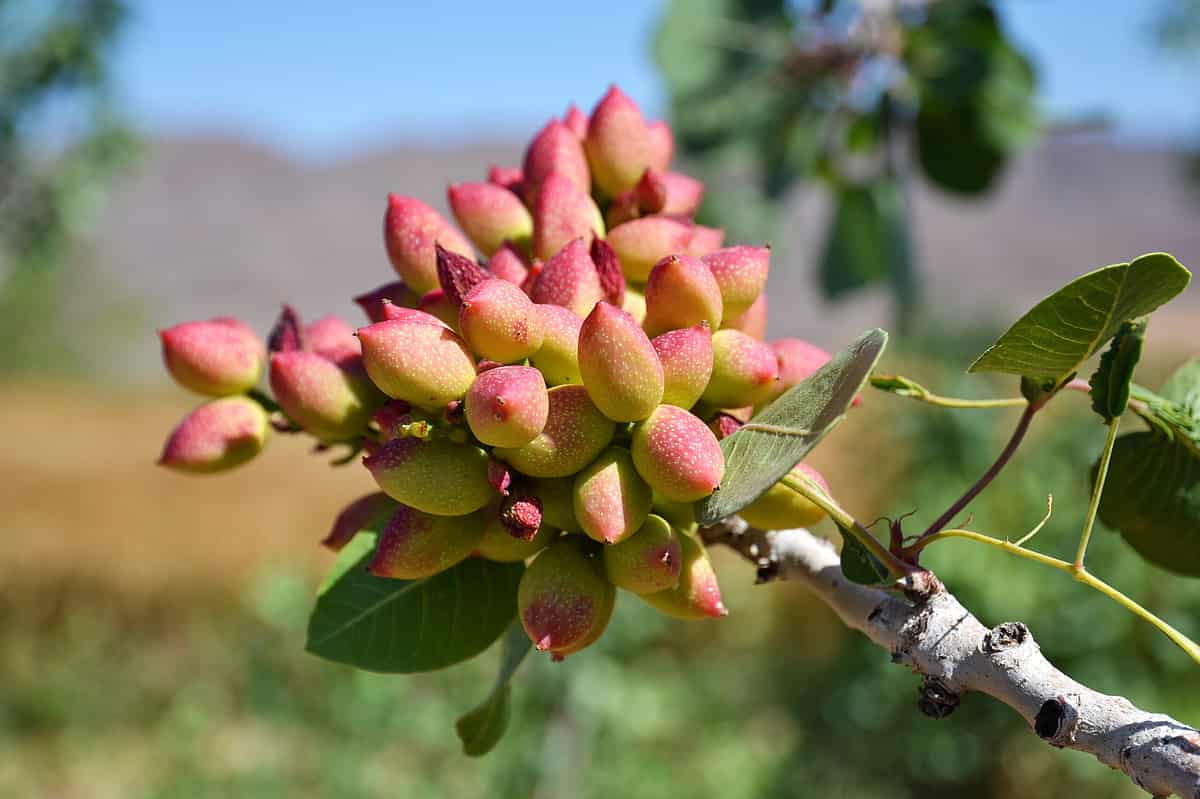
Here, you'll see a pistachio tree with ripening fruit. Inside that fruit, somewhere, is the pistachio seed!
©iStock.com/klaravlas
Recipes Using Pistachios
Like almonds, you can chop up pistachios for a garnish. You can roast them for snacking and grind them up for pistachio butter. Pistachios make up desserts like baklava and halvah. Pistachio is also a common flavor of ice cream. The BBC recommends pistachio tea cake, pistachio blondies, and even an apricot & pistachio frangipane tart. They're fantastic in salads or cooked into meatballs. Simply put, there are so many ways to stylize this versatile nut (seed!) to fit the needs of your meal.
Nutritional Value
In terms of the nutritional value of almonds vs. pistachios, refer to the chart below for a handy breakdown. The important facts are that 1 ounce of almonds vs. 1 ounce of pistachios have similar levels of protein, calories, and fat. Pistachios rank slightly higher in iron and zinc content, but both nuts (seeds!) are heart-healthy, nutritional options overall.
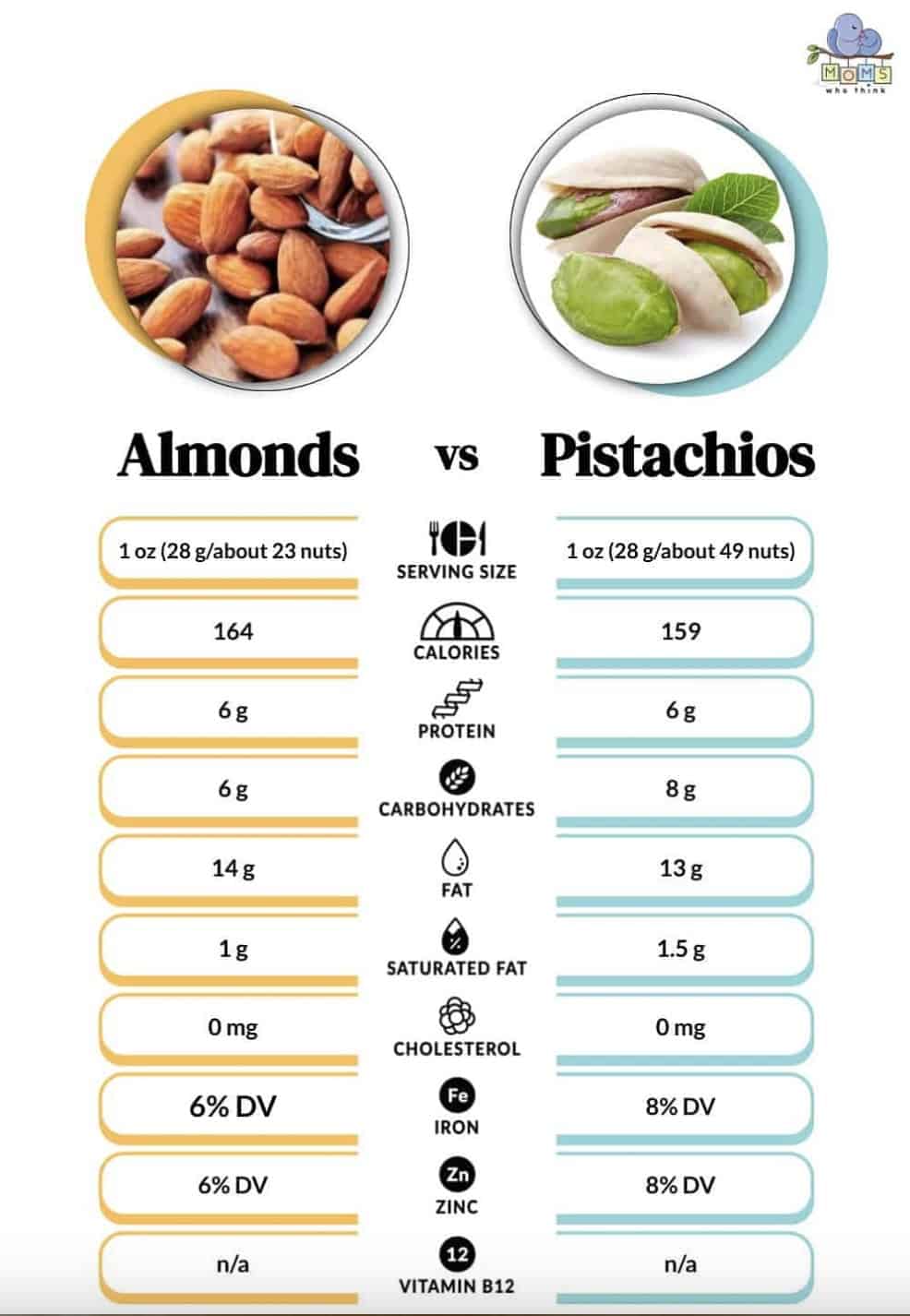
Possible Alternatives to Almonds and/or Pistachios
If almonds or pistachios simply won't do, there are other nuts to try. Try the cashew or the walnut. There are macadamia nuts, brazil nuts, butternut, and pine nuts. And you can always go for the classic nut, peanuts! Each nut will provide its own flavor to whatever you are producing, but in terms of consistency and replacement, all of these nuts will do in a pinch for recipes involving either almonds or pistachios.
Almonds vs. Pistachios: Are They the Same Thing?
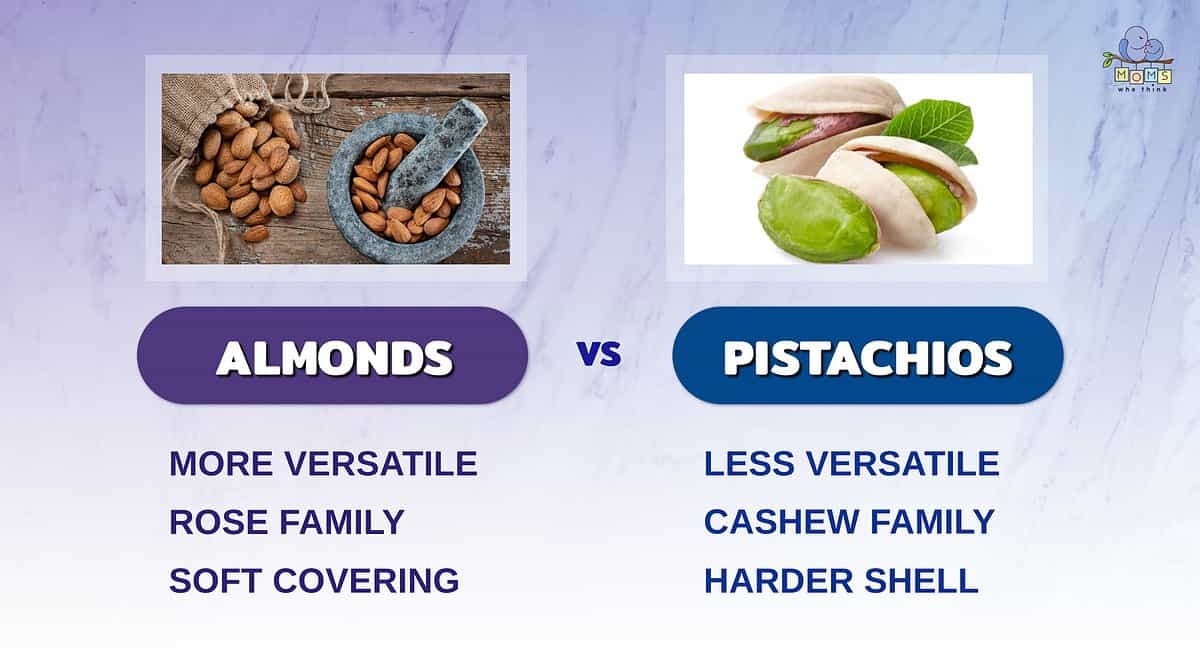
Both popular in their own right, almonds and pistachios have quite a few similarities, especially in terms of how they are used in food. However, they also have a few differences, as noted in this article. Let's recap a few:
- Pistachios and almonds are great in many different desserts, milks, and even topping a salad, making them versatile nuts or seeds. However, almonds are known to be even more versatile.
- Almonds have a softer outer covering, whereas pistachios come in a hard shell.
- It may be surprising to know that almonds come from the rose family, while pistachios are actually part of the cashew family.
When considering almonds vs. pistachios, it is clear they are not the same nut or seed. They come from different plants and have different tastes, appearances, flavor profiles, and nutritional components. However, you can use them for similar recipes. Both are great for baking and for general snacking. Both make wonderful garnishes and kinds of butter. Whichever you pick, it's sure to be a wonderful meal.
Still on the hunt for a great recipe to try? Give these simple, chewy almond macaroons a try:
PrintSimple, Chewy Almond Macaroons
Ingredients
- 1 (7 ounces) package of almond paste
- 1/4 cup all-purpose flour
- 1 1/4 cups powdered sugar
- 1/4 teaspoon almond extract
- 2 egg whites
- 3 dozen blanched whole almonds
Instructions
1. Preheat oven to 325 degrees Fahrenheit and grease a cookie sheet or line with parchment paper.
2. Crumble almond paste into small pieces in a large bowl.
3. In the same bowl, stir in almond extract, flour, and powdered sugar. Add egg whites and beat with an electric mixer on medium speed for about 2 minutes, until smooth.
4. Place dough by small spoonfuls onto the prepared cookie sheet, approximately 2 inches apart.
5. Place an almond on top of each cookie, then refrigerate for 30 minutes.
6. Bake for around 12 minutes or until set. Immediately remove from cookie sheet to wire rack and let cool completely.
The image featured at the top of this post is ©iStock.com/Gulcin Ragiboglu


